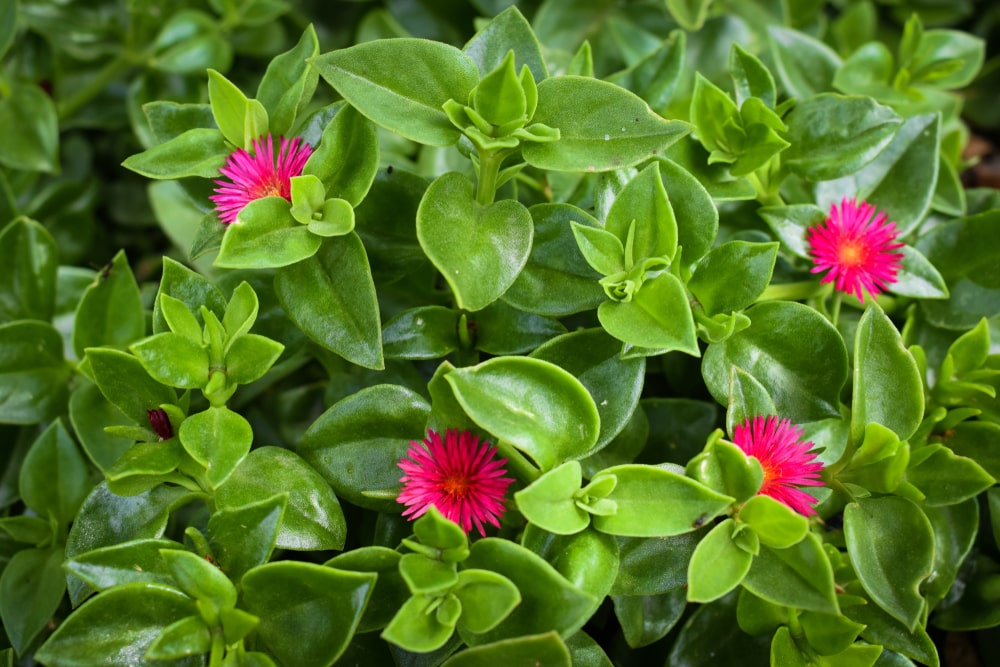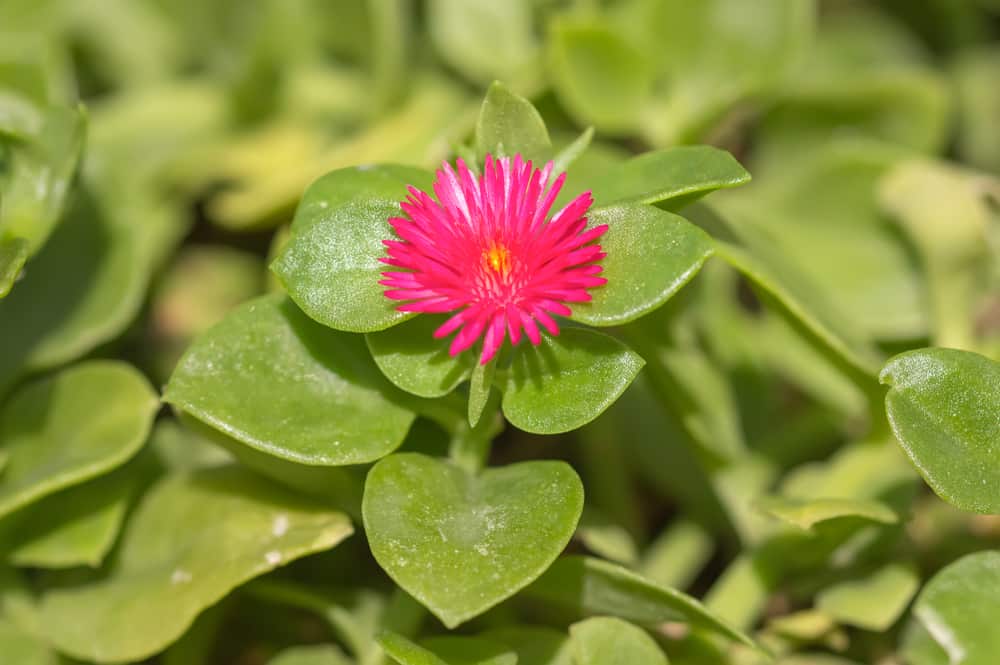Forming a carpet of glossy green leaves, the Baby Sun Rose is a plant that’s perfect for adding some extra color and life to your home garden. These sun-loving ice plants are easy to care for, making them a great choice for gardeners of all levels of experience.
This low-growing plant is perennial and native to South Africa. It is widely known for its ability to thrive in hot, dry climates and poor soil conditions. Being succulent, it stores water in its leaves, stems, or roots and allows the plant to survive in hot, dry climates where water is scarce.

| Botanical Name | Mesembryanthemum cordifolium, formerly known as Aptenia cordifolia ‘Variegata’ |
| Common Name | Baby Sun Rose, Heart-Leaf Ice Plant |
| Plant Type | Perennial |
| Flower Color | Reddish-purple to Pinkish-purple |
| Size When Mature | 6-12 Inches |
| Bloom Time | Early Spring to Summer |
| Sun Requirements | Full Sun to Partial Shade |
| USDA Hardiness Zones | 9-10 |
| Soil PH Range | 6.1-6.5 |
| Soil Type | Loam, Sand, well-draining |
| Water Needs | Low |
| Native Area | South Africa |
What You Need to Know About Baby Sun Rose
The leaves of the Baby Sun Rose are thick and fleshy, with a deep green color. The flowers of the plant are bright red, or reddish-purple to pinkish-purple. The flowers bloom individually, in clusters from early spring to summer.
Its blooms are very inviting to pollinators such as butterflies and bees. It also entices hummingbirds to come and visit your garden. Following its bloom, the fruits will soon start to appear and it will look like a capsule that is approximately a centimeter long.
The Baby Sun Rose is a low-maintenance plant that is easy to care for. It is drought tolerant and can handle extended periods of dry weather conditions. While the plant is not poisonous, the tap may irritate the skin so it is still best to keep it away from pets and small children who might try to nibble on the leaves.
How to Care for Baby Sun Rose
Here’s everything you need to know about growing and caring for a thriving Baby Sun Rose
Light
Baby Sun Roses love basking in the sun, so make sure to plant them in an area that gets plenty of direct sunlight. They’ll do best in an area that receives at least six hours of sunlight each day.
When grown as indoor house plants, choose a spot in your home that gets plenty of light. It should also be rotated to ensure that all sides of the plant get an equal amount of light.
Water and Soil Needs
Just like any other succulent, Baby Sun Rose is a plant that doesn’t need too much water to survive. In fact, it can actually tolerate long periods of drought. However, this doesn’t mean that you should neglect it completely.
Although it can withstand dry conditions, the plant will still thrive if you water it regularly. If you live in an area with hot summers, then you should water your Baby Sun Rose more frequently. During the cooler months, you can cut back on watering and allow the soil to dry out completely between watering.
These plants are tolerant of a wide range of soil types, but they prefer loamy or sandy, well-drained soil that is not too rich in nutrients. If you’re planting in pots, make sure to use a potting mix that is specifically designed for succulents. They can thrive in soil with any pH but will more likely do well in soils with a pH of 6.1 to 6.5.
Temperature Requirements
This ice plant is winter hardy in USDA zones 9 to 10. They can withstand freezing temperatures as long as they are not exposed to prolonged frost. If you live in an area with cooler winters, you can still grow Baby Sun Rose as long as you provide protection from the cold.
Fertilizer
The best fertilizer to use on a Baby Sun Rose is a controlled release fertilizer. Baby Sun Rose is a succulent that doesn’t need much fertilizer. In fact, too much fertilizer can actually damage the plant so you can just feed it twice a year, in spring and in summer.
Common Diseases
If kept in humid areas and conditions, succulents are prone to root rot. To avoid your Baby Sun Rose from experiencing this problem, it is best to let the soil dry out completely between watering. If you notice that the leaves of your plant are starting to turn yellow, this is a sign of over-watering and you should cut back on watering immediately.
The most common pests that attack succulents are mealybugs and scale insects. Mealybugs are small, white insects that are attracted to the moisture in the leaves of the plant. They will suck the sap from the leaves, which can eventually lead to leaf drops. On the other hand, scale insects affect your plant in a negative way by feeding on the sap. They will also secrete a sticky substance that can attract ants.
However, the ants are relatively harmless. If you notice either of these pests on your plant, it is best to take action immediately. To get rid of them, you can either use an insecticide or spray the plant with soapy water.
Baby Sun Rose Propagation
To propagate Baby Sun Rose, you have three options to choose from. You can use cuttings, by division, or by using seeds. In using cuttings, you have to take a 3- to 4-inch cutting from a healthy plant and root them in water.
When the roots finally appear, you can then plant the cutting in the soil. When propagating by division, simply divide runners from the main plant. Lastly, you can do it by using its seeds. Sow the seeds in well-draining soil and keep them moist until they germinate.
Related Article: Moss Rose Care

